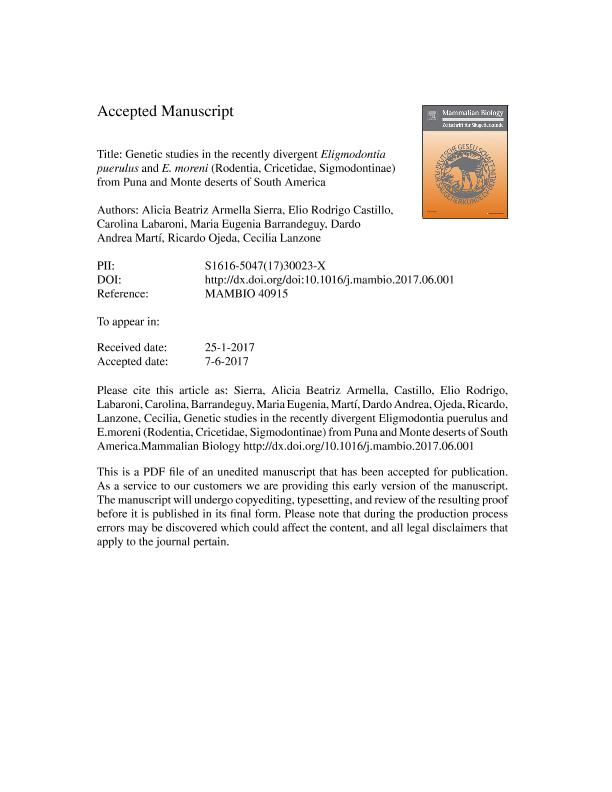Mostrar el registro sencillo del ítem
dc.contributor.author
Armella Sierra, Alicia Beatriz

dc.contributor.author
Castillo, Elio Rodrigo Daniel

dc.contributor.author
Labaroni, Carolina Alicia

dc.contributor.author
Barrandeguy, Maria Eugenia

dc.contributor.author
Marti, Dardo Andrea

dc.contributor.author
Ojeda, Ricardo Alberto

dc.contributor.author
Lanzone, Cecilia

dc.date.available
2018-10-29T20:14:40Z
dc.date.issued
2017-11
dc.identifier.citation
Armella Sierra, Alicia Beatriz; Castillo, Elio Rodrigo Daniel; Labaroni, Carolina Alicia; Barrandeguy, Maria Eugenia; Marti, Dardo Andrea; et al.; Genetic studies in the recently divergent Eligmodontia puerulus and E. moreni (Rodentia, Cricetidae, Sigmodontinae) from Puna and Monte deserts of South America; Elsevier Gmbh; Mammalian Biology; 87; 11-2017; 93-100
dc.identifier.issn
1616-5047
dc.identifier.uri
http://hdl.handle.net/11336/63249
dc.description.abstract
Eligmodontia is a genus of phyllotine rodents adapted to arid environments with seven recognized species. The sister species E. puerulus and E. moreni are distributed in the adjacent highland Puna and lowland Monte deserts respectively, and show remarkable morphological and chromosomal differences. However, analyses of the cytochrome b gene showed important variability, without reciprocal monophyly between them. In order to study the evolutionary processes involved in the diversification of both taxa, we analyzed 1161 bp of the mitochondrial control region and flanking sequences (N = 60), as well as 759 bp of the first exon of the nuclear gene IRBP (N = 14). Individuals of both species from Jujuy, Catamarca and Mendoza Provinces of Argentina were previously karyotyped. Results showed that the mitochondrial sequences present high haplotype and nucleotide diversity within all population, and no haplotype was shared between both species. FST indicated that populations of both species were moderately structured. The network was constituted by two major haplogroups, one composed by E. puerulus samples from Jujuy, and the other composed of sequences of all studied populations. The Bayesian analysis showed three clusters, matching the network. Phylogenetic analysis recovered two clades with high support, in coincidence with the network groups. There was only one close join between sequences of both species, corresponding to samples from Catamarca. Thus, mitochondrial data suggested hybridization between both species in Catamarca, with asymmetric introgression. The IRBP showed low variability and, in the phylogenetic analysis, the sequences of E. puerulus form a monophyletic group with intermediate support, whereas those of E. moreni collapse into a basal polytomy. Our data indicated a recent divergence and absence of introgression in the nuclear genomes. The results at the population level with mitochondrial sequences, together with integrative taxonomy at the species level in a biogeographic context, suggest that climatic and geologic changes could have had an important role in the determination of genetic variability patterns observed in these rodents.
dc.format
application/pdf
dc.language.iso
eng
dc.publisher
Elsevier Gmbh

dc.rights
info:eu-repo/semantics/openAccess
dc.rights.uri
https://creativecommons.org/licenses/by-nc-nd/2.5/ar/
dc.subject
Hybridization
dc.subject
Population Genetics
dc.subject
Sister Species
dc.subject
South American Rodents
dc.subject
Speciation
dc.subject
Variability
dc.subject.classification
Otras Ciencias Biológicas

dc.subject.classification
Ciencias Biológicas

dc.subject.classification
CIENCIAS NATURALES Y EXACTAS

dc.title
Genetic studies in the recently divergent Eligmodontia puerulus and E. moreni (Rodentia, Cricetidae, Sigmodontinae) from Puna and Monte deserts of South America
dc.type
info:eu-repo/semantics/article
dc.type
info:ar-repo/semantics/artículo
dc.type
info:eu-repo/semantics/publishedVersion
dc.date.updated
2018-10-29T17:02:26Z
dc.journal.volume
87
dc.journal.pagination
93-100
dc.journal.pais
Alemania

dc.description.fil
Fil: Armella Sierra, Alicia Beatriz. Consejo Nacional de Investigaciones Científicas y Técnicas. Centro Científico Tecnológico Conicet - Nordeste. Instituto de Biología Subtropical. Instituto de Biología Subtropical - Nodo Posadas | Universidad Nacional de Misiones. Instituto de Biología Subtropical. Instituto de Biología Subtropical - Nodo Posadas; Argentina
dc.description.fil
Fil: Castillo, Elio Rodrigo Daniel. Consejo Nacional de Investigaciones Científicas y Técnicas. Centro Científico Tecnológico Conicet - Nordeste. Instituto de Biología Subtropical. Instituto de Biología Subtropical - Nodo Posadas | Universidad Nacional de Misiones. Instituto de Biología Subtropical. Instituto de Biología Subtropical - Nodo Posadas; Argentina
dc.description.fil
Fil: Labaroni, Carolina Alicia. Consejo Nacional de Investigaciones Científicas y Técnicas. Centro Científico Tecnológico Conicet - Nordeste. Instituto de Biología Subtropical. Instituto de Biología Subtropical - Nodo Posadas | Universidad Nacional de Misiones. Instituto de Biología Subtropical. Instituto de Biología Subtropical - Nodo Posadas; Argentina
dc.description.fil
Fil: Barrandeguy, Maria Eugenia. Consejo Nacional de Investigaciones Científicas y Técnicas. Centro Científico Tecnológico Conicet - Nordeste. Instituto de Biología Subtropical. Instituto de Biología Subtropical - Nodo Posadas | Universidad Nacional de Misiones. Instituto de Biología Subtropical. Instituto de Biología Subtropical - Nodo Posadas; Argentina
dc.description.fil
Fil: Marti, Dardo Andrea. Consejo Nacional de Investigaciones Científicas y Técnicas. Centro Científico Tecnológico Conicet - Nordeste. Instituto de Biología Subtropical. Instituto de Biología Subtropical - Nodo Posadas | Universidad Nacional de Misiones. Instituto de Biología Subtropical. Instituto de Biología Subtropical - Nodo Posadas; Argentina
dc.description.fil
Fil: Ojeda, Ricardo Alberto. Consejo Nacional de Investigaciones Científicas y Técnicas. Centro Científico Tecnológico Conicet - Mendoza. Instituto Argentino de Investigaciones de las Zonas Áridas. Provincia de Mendoza. Instituto Argentino de Investigaciones de las Zonas Áridas. Universidad Nacional de Cuyo. Instituto Argentino de Investigaciones de las Zonas Áridas; Argentina
dc.description.fil
Fil: Lanzone, Cecilia. Consejo Nacional de Investigaciones Científicas y Técnicas. Centro Científico Tecnológico Conicet - Nordeste. Instituto de Biología Subtropical. Instituto de Biología Subtropical - Nodo Posadas | Universidad Nacional de Misiones. Instituto de Biología Subtropical. Instituto de Biología Subtropical - Nodo Posadas; Argentina
dc.journal.title
Mammalian Biology

dc.relation.alternativeid
info:eu-repo/semantics/altIdentifier/doi/http://dx.doi.org/10.1016/j.mambio.2017.06.001
dc.relation.alternativeid
info:eu-repo/semantics/altIdentifier/url/https://www.sciencedirect.com/science/article/pii/S161650471730023X
Archivos asociados
